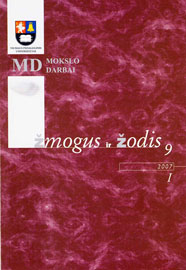Argumentacija: įrodymo ir įtikinimo santykis
Argumentation: the Relation between Proof and Persuasion
Author(s): Zita NauckūnaitėSubject(s): Language and Literature Studies
Published by: Vytauto Didžiojo Universitetas
Keywords: proof; persuasion; logical arguments; emotional arguments; aesthetical arguments
Summary/Abstract: From 2008 the Final Lithuanian native examination will include the task of writing an argumentative non-fiction essay. That is where the problem of the quality of an argument comes in. An argument should be based on the truth, but not on the effect caused by simulacrum. The present article deals with the relation of main dimensions of argumentation - those of proof and persuasion. Stress is laid on the statement that even though logics and rationality should be evaluated far more than the image of the author or his appeal to the emotions of the addressee, often the author finds formai reasoning difficult, the audience is bored, and as a result, rhetoric language prevails. Argumentative texts may appeal to the intellect, emotions and aesthetical experiences of the addressee; therefore, the article revievvs the three kinds of argumentation in detail. It is evident that logical arguments have the strongest direct effect on the mind, emotional arguments influence feelings and aesthetical arguments stimulate imagination; however, any argument mentioned above makes stronger or weaker peripheral effect on the addressee. The flow of speech is linear, and when we normally conceive the discourse we do not analyse whether it appeals to the mind, emotions or imagination. Nevertheless, the appeal to emotions is apowerful rhetoric technique, which is often misused by politicians, journalists and advertisers. Thus, the article emphasises that one of the main tasks of teaching argumentation is to equip schoolchildren with the knowledge and skills necessary for the analysis of argumentation and to teach they to focus on thought which is the foundation of the text.
Journal: Žmogus ir žodis
- Issue Year: 09/2007
- Issue No: 1
- Page Range: 94-100
- Page Count: 12
- Language: Lithuanian

